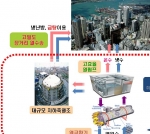KIER Pioneers Catalyst Innovation to Power the Clean Fuel Era
Copper–magnesium–iron catalyst achieves 1.7× faster carbon monoxide formation and 1.5× higher yield at low temperature, advancing carbon recycling and e-fuel production technologies.
Traditional nickel-based catalysts offer excellent thermal stability, but require reaction temperatures exceeding 800 °C. Prolonged operation at such high temperatures causes particle agglomeration, leading to loss of activity. At lower temperatures, methane byproducts are generated, lowering CO selectivity.
To address these challenges, the KIER team developed a cost-effective copper-based mixed oxide catalyst that demonstrates high CO productivity even at 400 °C. The new catalyst achieved a 1.7-fold higher CO formation rate and a 1.5-fold higher yield than commercial copper catalysts.
Copper catalysts can selectively produce CO without forming methane below 400 °C, but often suffer from poor thermal stability. KIER’s innovation uses a layered double hydroxide (LDH)-derived structure incorporating iron and magnesium, which fills the gaps between copper particles, prevents agglomeration, strengthens Cu-FeOx interactions, and significantly enhances durability.
Spectroscopic analyses confirmed that the new catalyst directly converts CO₂ into CO on its surface—bypassing formate intermediates common in conventional copper catalysts. It achieved a CO yield of 33.4% and a formation rate of 223.7 μmol·gcat⁻¹·s⁻¹, maintaining stable performance for over 100 hours.
Dr. Koo stated, “This low-temperature CO₂ hydrogenation catalyst enables the efficient and economical carbon monoxide production using abundant metals, paving the way toward industrial-scale sustainable fuel synthesis and carbon-neutral energy systems.”
The research was published online in May 2025 in Applied Catalysis B: Environmental and Energy (Impact Factor 21.1) and supported by KIER’s R&D project on e-SAF (sustainable aviation fuel) production from CO₂ and H₂.
Website: http://www.kier.re.kr
Contact
Korea Institute of Energy Research
For PR inquiry
Dr. Kim Il-Ja
+82-42-860-3496
Send Email
For research inquiry
Dr. Koo Kee-Young
+82-42-860-3192
Send Email
This news is a press release provided by Korea Institute of Energy Research.





